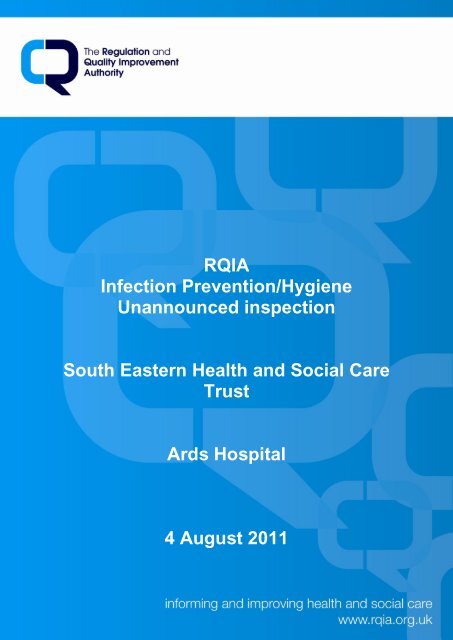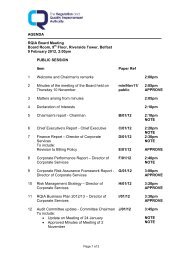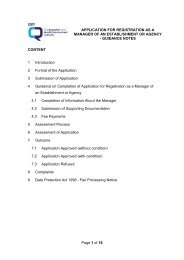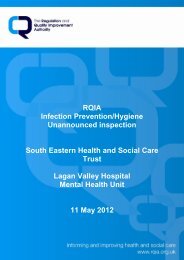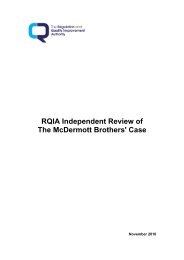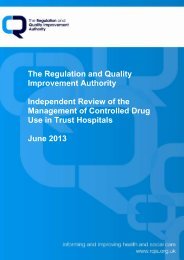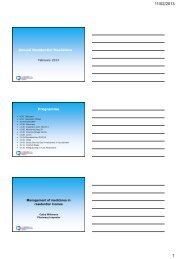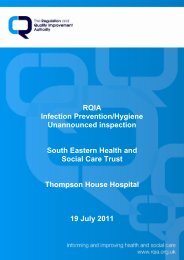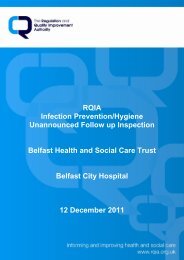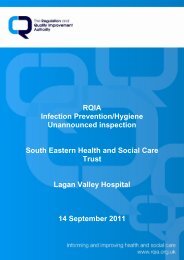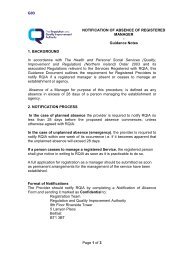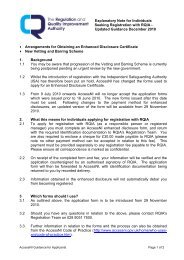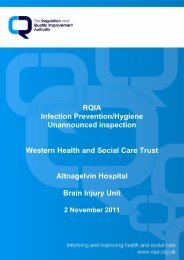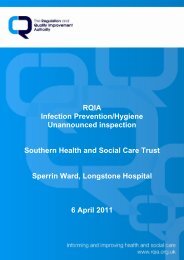Ards Hospital, Newtownards - 04 August 2011 - Regulation and ...
Ards Hospital, Newtownards - 04 August 2011 - Regulation and ...
Ards Hospital, Newtownards - 04 August 2011 - Regulation and ...
You also want an ePaper? Increase the reach of your titles
YUMPU automatically turns print PDFs into web optimized ePapers that Google loves.
RQIA<br />
Infection Prevention/Hygiene<br />
Unannounced inspection<br />
South Eastern Health <strong>and</strong> Social Care<br />
Trust<br />
<strong>Ards</strong> <strong>Hospital</strong><br />
4 <strong>August</strong> <strong>2011</strong><br />
[Type text]
Contents<br />
1.0 Inspection Summary 1<br />
2.0 Background Information to the Inspection Process 5<br />
3.0 Inspections 6<br />
4.0 Unannounced Inspection Process 7<br />
4.1 Onsite Inspection 7<br />
4.2 Feedback <strong>and</strong> Report of the findings 7<br />
5.0 Audit Tool 8<br />
6.0 Environment 10<br />
6.1 Cleaning 10<br />
6.2 Clutter 11<br />
6.3 Maintenance <strong>and</strong> Repair 12<br />
6.4 Fixture <strong>and</strong> Fittings 12<br />
6.5 Information 12<br />
6.6 Additional Issues 13<br />
7.0 Patient Linen 15<br />
7.1 Management of Linen 15<br />
8.0 Waste <strong>and</strong> Sharps 17<br />
8.1 Waste 17<br />
8.2 Sharps 17<br />
9.0 Patient Equipment 19<br />
10.0 Hygiene Factors 21<br />
11.0 Hygiene Practice 24<br />
12.0 Key Personnel <strong>and</strong> Information 25<br />
13.0 Summary of Recommendations 27<br />
14.0 Unannounced Inspection Flowchart 29<br />
15.0 RQIA Hygiene Team Escalation Policy Flowchart 30<br />
16.0 Action Plan 31
1.0 Inspection Summary<br />
An unannounced inspection was undertaken to the <strong>Ards</strong> <strong>Hospital</strong>, on<br />
the 4 <strong>August</strong> <strong>2011</strong>. The hospital was assessed against the Regional<br />
Healthcare Hygiene <strong>and</strong> Cleanliness st<strong>and</strong>ards <strong>and</strong> the following area<br />
was inspected:<br />
G.P. Ward<br />
The GP Ward is a 14 bedded unit however at present bed occupancy<br />
has been increased to 20 beds. The ward provides care for patients<br />
with acute medical conditions, who would previously have been<br />
admitted to the Ulster <strong>Hospital</strong>. In addition to medical conditions<br />
treated, other care provided includes:<br />
Blood transfusions<br />
Therapy <strong>and</strong> rehabilitation<br />
Chronic disease management<br />
Palliative care<br />
Patients are cared for in this local environment by GPs supported by<br />
specially trained nurses, physiotherapists <strong>and</strong> occupational therapists.<br />
Inspection Outcomes<br />
The GP ward achieved overall an compliance level. Inspectors<br />
observed that the environment in general required attention to detail<br />
when cleaning <strong>and</strong> de-cluttering, with issues identified for<br />
improvement. Overall the observation of staff indicated compliance<br />
with hygiene <strong>and</strong> infection prevention <strong>and</strong> control practices.<br />
The inspection resulted in 15 recommendations for the SEHSCT <strong>and</strong><br />
the <strong>Ards</strong> <strong>Hospital</strong>, a full list of recommendations is listed in Section 13.<br />
A detailed list of preliminary findings is forwarded to South Eastern<br />
Health <strong>and</strong> Social Care Trust within 14 days of the inspection to enable<br />
early action on identified areas which have achieved non complaint<br />
scores. The draft report which includes the high level<br />
recommendations in a Quality Improvement Plan is forwarded within 28<br />
days of the inspection for agreement <strong>and</strong> factual accuracy. The draft<br />
report is agreed <strong>and</strong> a completed action plan is returned to RQIA within<br />
14 days from the date of issue. The detailed list of preliminary findings<br />
is available from RQIA on request.<br />
The final report <strong>and</strong> Quality Improvement Plan will be available on the<br />
RQIA website. Reports <strong>and</strong> action plans will be subject to performance<br />
management by the Health <strong>and</strong> Social Care Board <strong>and</strong> the Public<br />
Health Agency.<br />
1
Notable Practice<br />
The inspection identified the following areas of notable practice<br />
Implementation of high impact intervention care bundles for<br />
peripheral vascular catheters <strong>and</strong> urinary catheters<br />
Fully completed MRSA care plan <strong>and</strong> good documentation<br />
Implementation of h<strong>and</strong> hygiene <strong>and</strong> mattress audits<br />
The introduction of disposable patient privacy curtains<br />
Domestic services ward cleaning schedule on display for the<br />
general public<br />
5 star kitchen rating <strong>and</strong> new easily cleanable kitchen notice<br />
board<br />
The RQIA inspection team would like to thank the staff at the <strong>Ards</strong><br />
<strong>Hospital</strong> for their assistance during the inspection.<br />
The following tables give an overview of compliance scores noted in<br />
areas inspected by RQIA:<br />
Table 1 summarises the overall compliance levels achieved.<br />
Tables 2-7 summarise the individual tables for sections two to seven of<br />
the audit tool as this assists organisation to target areas that require<br />
more specific attention.<br />
Table 1<br />
GP. Ward<br />
Environment 73<br />
Patient Linen 85<br />
Waste 97<br />
Sharps 89<br />
Equipment 78<br />
Hygiene Factors 85<br />
Hygiene Practices 92<br />
Average Score 86<br />
Compliant:<br />
85% or above<br />
Partial Compliance: 76% to 84%<br />
Minimal Compliance: 75% or below<br />
2
Table 2<br />
Environment<br />
Reception 85<br />
Corridors, stairs lift 77<br />
Public toilets<br />
N/A<br />
Ward/ department -<br />
general(communal)<br />
65<br />
Patient bed area 85<br />
Bathroom/washroom 81<br />
Toilet 74<br />
Clinical room/ treatment<br />
room<br />
28<br />
Clean utility room<br />
N/A<br />
Dirty utility room 63<br />
Domestic store 64<br />
Kitchen 85<br />
Equipment store 79<br />
Isolation 85<br />
General information 80<br />
Average Score 73<br />
Table 3<br />
Linen<br />
Storage of clean linen 78<br />
Storage of used linen 92<br />
Laundry facilities<br />
N/A<br />
Average Score 85<br />
Table 4<br />
Waste <strong>and</strong> sharps<br />
H<strong>and</strong>ling, segregation,<br />
storage, waste<br />
Availability, use, storage of<br />
sharps<br />
Average score<br />
97<br />
89<br />
Compliant:<br />
85% or above<br />
Partial Compliance: 76% to 84%<br />
Minimal Compliance: 75% or below<br />
3
Table 5<br />
Patient Equipment<br />
Patient equipment<br />
78<br />
Table 6<br />
Hygiene Factors<br />
Availability <strong>and</strong> cleanliness<br />
of wash h<strong>and</strong> basin <strong>and</strong><br />
84<br />
consumables<br />
Availability of alcohol rub 100<br />
Availability of PPE 77<br />
Materials <strong>and</strong> equipment<br />
for cleaning<br />
78<br />
Average Score 85<br />
Table 7<br />
Hygiene practices<br />
Effective h<strong>and</strong> hygiene<br />
procedures<br />
82<br />
Safe h<strong>and</strong>ling <strong>and</strong> disposal<br />
of sharps<br />
100<br />
Effective use of PPE 80<br />
Correct use of isolation 100<br />
Effective cleaning of ward 90<br />
Staff uniform <strong>and</strong> work<br />
wear<br />
100<br />
Average Score 92<br />
Compliant:<br />
85% or above<br />
Partial Compliance: 76% to 84%<br />
Minimal Compliance: 75% or below<br />
4
2.0 Background Information to the Inspection Process<br />
RQIA’s infection prevention <strong>and</strong> hygiene team was established to<br />
undertake a rolling programme of unannounced inspections of acute<br />
hospitals. The Department of Health Social Service <strong>and</strong> Public Safety<br />
(DHSSPS) commitment to a programme of hygiene inspections was<br />
reaffirmed through the launch in 2010 of the revised <strong>and</strong> updated<br />
version of 'Changing the Culture' the strategic regional action plan for<br />
the prevention <strong>and</strong> control of healthcare-associated infections (HCAIs)<br />
in Northern Irel<strong>and</strong>.<br />
The aims of the inspection process are:<br />
to provide public assurance <strong>and</strong> to promote public trust <strong>and</strong><br />
confidence<br />
to contribute to the prevention <strong>and</strong> control of HCAI<br />
to contribute to improvement in hygiene, cleanliness <strong>and</strong> infection<br />
prevention <strong>and</strong> control across health <strong>and</strong> social care in Northern<br />
Irel<strong>and</strong><br />
In keeping with the aims of the RQIA, the team will adopt an open <strong>and</strong><br />
transparent method for inspection, using st<strong>and</strong>ardised processes <strong>and</strong><br />
documentation.<br />
5
3.0 Inspections<br />
The DHSSPS have devised Regional Healthcare Hygiene <strong>and</strong><br />
Cleanliness st<strong>and</strong>ards <strong>and</strong> accompanying regional audit tool. RQIA<br />
has revised their inspection processes to support the publication of the<br />
st<strong>and</strong>ards which were compiled by a regional steering group in<br />
consultation with service providers. One of the st<strong>and</strong>ards relates to<br />
organisational systems <strong>and</strong> governance, to ensure compliance with<br />
this, a new inspection process <strong>and</strong> methodology process has been<br />
developed in consultation with the regional steering group.<br />
RQIA's infection prevention/hygiene team have planned a three year<br />
programme which includes announced <strong>and</strong> unannounced inspections<br />
in acute <strong>and</strong> non-acute hospitals in Northern Irel<strong>and</strong>. This will assess<br />
compliance with the DHSSPS Regional Healthcare Hygiene <strong>and</strong><br />
Cleanliness st<strong>and</strong>ards.<br />
The inspections will be undertaken in accordance with the four core<br />
activities outlined in the RQIA Corporate Strategy, these include:<br />
Improving care: we encourage <strong>and</strong> promote improvements in the<br />
safety <strong>and</strong> quality of services through the regulation <strong>and</strong> review of<br />
health <strong>and</strong> social care<br />
Informing the population: we publicly report on the safety,<br />
quality <strong>and</strong> availability of health <strong>and</strong> social care<br />
Safeguarding rights: we act to protect the rights of all people<br />
using health <strong>and</strong> social care services<br />
Influencing policy: we influence policy <strong>and</strong> st<strong>and</strong>ards in health<br />
<strong>and</strong> social care<br />
6
4.0 Unannounced Inspection Process<br />
Trusts receive no advanced notice of the onsite inspection. An email<br />
<strong>and</strong> telephone call will be made by the Chief Executive of RQIA or<br />
nominated person 30 minutes prior to the team arriving on site. The<br />
inspection flow chart is attached in Section 14.<br />
4.1 Onsite Inspection<br />
The inspection team was made up of two inspectors, from RQIA’s<br />
infection prevention/hygiene team. One inspector led the team <strong>and</strong><br />
was responsible for guiding the team <strong>and</strong> ensuring they were in<br />
agreement about the findings reached. Membership of the inspection<br />
team is outlined in Section 12.<br />
The inspection of ward environments is carried out using the Regional<br />
Healthcare Hygiene <strong>and</strong> Cleanliness audit tool. The inspection<br />
process involves observation, discussion with staff, <strong>and</strong> review of some<br />
ward documentation.<br />
4.2 Feedback <strong>and</strong> Report of the Findings<br />
The process concludes with a feedback of key findings to trust<br />
representatives including examples of notable practice identified during<br />
the inspection. The details of trust representatives attending the<br />
feedback session is outlined in Section 12.<br />
The findings, report <strong>and</strong> follow up action will be in accordance with the<br />
Infection Prevention/ Hygiene Inspection Process (methodology, follow<br />
up <strong>and</strong> reporting).<br />
The infection prevention/ hygiene team escalation process will be<br />
followed if inspectors/ reviewers identify any serious concerns during<br />
the inspection (Section 15).<br />
A number of documents have been developed to support <strong>and</strong> explain<br />
the inspection process. This information is currently available on<br />
request <strong>and</strong> will be available in due course on the RQIA website.<br />
7
5.0 Audit Tool<br />
The audit tool used for the inspection is based on the Regional<br />
Healthcare Hygiene <strong>and</strong> Cleanliness st<strong>and</strong>ards. The st<strong>and</strong>ards<br />
incorporate the critical areas which were identified through a review of<br />
existing st<strong>and</strong>ards, guidance <strong>and</strong> audit tools (Appendix 2 of Regional<br />
Healthcare Hygiene <strong>and</strong> Cleanliness st<strong>and</strong>ards). The audit tool follows<br />
the format of the Regional Healthcare Hygiene <strong>and</strong> Cleanliness<br />
st<strong>and</strong>ards <strong>and</strong> comprises of the following sections.<br />
1. Organisational Systems <strong>and</strong> Governance: policies <strong>and</strong><br />
procedures in relation to key hygiene <strong>and</strong> cleanliness issues;<br />
communication of policies <strong>and</strong> procedures; roles <strong>and</strong><br />
responsibilities for hygiene <strong>and</strong> cleanliness issues; internal<br />
monitoring arrangements; arrangements to address issues<br />
identified during internal monitoring; communication of internal<br />
monitoring results to staff<br />
This st<strong>and</strong>ard is not audited when carrying out unannounced<br />
inspections however the findings of the organisational system<br />
<strong>and</strong> governance at annual announced inspection will be,<br />
where applicable, confirmed at ward level.<br />
2. General Environment: cleanliness <strong>and</strong> state of repair of public<br />
areas; cleanliness <strong>and</strong> state of repair of ward/ department<br />
infrastructure; cleanliness <strong>and</strong> state of repair of patient bed area;<br />
cleanliness <strong>and</strong> state of repair of toilets, bathrooms <strong>and</strong><br />
washrooms; cleanliness <strong>and</strong> state of repair of ward/ department<br />
facilities; availability <strong>and</strong> cleanliness of isolation facilities; provision<br />
of information for staff, patients <strong>and</strong> visitors<br />
3. Patient Linen: storage of clean linen; h<strong>and</strong>ling <strong>and</strong> storage of<br />
used linen; ward/ department laundry facilities<br />
4. Waste <strong>and</strong> Sharps: waste h<strong>and</strong>ling; availability <strong>and</strong> storage of<br />
sharps containers<br />
5. Patient Equipment: cleanliness <strong>and</strong> state of repair of general<br />
patient equipment<br />
6. Hygiene Factors: h<strong>and</strong> wash facilities; alcohol h<strong>and</strong> rub;<br />
availability of personal protective equipment (PPE); availability of<br />
cleaning equipment <strong>and</strong> materials<br />
7. Hygiene Practices: h<strong>and</strong> hygiene procedures; h<strong>and</strong>ling <strong>and</strong><br />
disposal of sharps; use of PPE; use of isolation facilities <strong>and</strong><br />
implementation of infection control procedures; cleaning of ward/<br />
department; staff uniform <strong>and</strong> work wear<br />
8
Level of Compliance<br />
Percentage scores can be allocated a level of compliance using the<br />
compliance categories below. The categories are allocated as follows:<br />
Compliant<br />
85% or above<br />
Partial compliance 76 to 84%<br />
Minimal compliance 75% or below<br />
Each section within the audit tool will receive an individual <strong>and</strong> an<br />
overall score, to identify areas of partial or minimal compliance to<br />
ensure that the appropriate action is taken.<br />
9
6.0 Environment<br />
STANDARD 2.0<br />
GENERAL ENVIRONMENT<br />
Cleanliness <strong>and</strong> state of repair of public areas; cleanliness <strong>and</strong><br />
state of repair of ward/department infrastructure; cleanliness <strong>and</strong><br />
state of repair of patient bed area; cleanliness <strong>and</strong> state of repair<br />
of toilets, bathrooms <strong>and</strong> washrooms; cleanliness <strong>and</strong> state of<br />
repair of ward/department facilities; availability <strong>and</strong> cleanliness<br />
of isolation facilities; provision of information for staff, patients<br />
<strong>and</strong> visitors.<br />
6.1 Cleaning<br />
Environment<br />
Reception 85<br />
Corridors, stairs lift 77<br />
Public toilets<br />
N/A<br />
Ward/ department -<br />
general(communal)<br />
65<br />
Patient bed area 85<br />
Bathroom/washroom 81<br />
Toilet 74<br />
Clinical room/ treatment room 28<br />
Clean utility room<br />
N/A<br />
Dirty utility room 63<br />
Domestic store 64<br />
Kitchen 85<br />
Equipment store 79<br />
Isolation 85<br />
General information 80<br />
Average Score 73<br />
At the time of the inspection there was evidence in some areas to<br />
indicate compliance with regional specifications for cleaning. However,<br />
the inspectors observed that while cleaning mechanisms were in place<br />
to prevent the build up of dust, debris <strong>and</strong> bacteria <strong>and</strong> subsequently<br />
reduce the potential risk for the transmission of infection, they were not<br />
always implemented or adhered to. The ward was non compliant for<br />
five criteria within this st<strong>and</strong>ard, with an overall non compliant score.<br />
In the main reception, corridors <strong>and</strong> stairs leading to the ward dust was<br />
observed behind radiators, high surfaces <strong>and</strong> external windows, frames<br />
<strong>and</strong> sills. Splash marks were noted on the wall outside the ward<br />
entrance <strong>and</strong> stains were observed on the ceiling, however the<br />
cleaning in these areas was generally satisfactory.<br />
10
Greater attention to detail is required throughout the ward when<br />
cleaning, as dust was observed behind fixtures <strong>and</strong> fitting, in corners<br />
<strong>and</strong> edges <strong>and</strong> doors. Inspectors observed that adhesive tape was<br />
used to attach labels or posters to walls, cupboards <strong>and</strong> doors, which in<br />
some instances had left a sticky residue, impeding the cleaning<br />
process.<br />
At the nurses’ station <strong>and</strong> treatment room, chairs were covered in fabric<br />
which was not easily cleaned; the chair in the treatment room was<br />
stained. In the shower/ toilet there was mould at the base of the<br />
shower, the edging of the shower door frame was dirty <strong>and</strong> the shower<br />
chair <strong>and</strong> raised toilet seat required cleaning, an issue also identified in<br />
the toilet. Inspectors observed in the toilets that the light pull cords<br />
were dirty <strong>and</strong> frayed <strong>and</strong> should be replaced. In the treatment room<br />
dead flies were noted in the ceiling light fitting, there were splash marks<br />
on the cupboard doors <strong>and</strong> the outside of the drugs’ fridge was stained.<br />
In the dirty utility room the edging of the macerator lid was dirty <strong>and</strong><br />
there was limescale on the h<strong>and</strong> washing sink taps. Limescale was<br />
also noted on the h<strong>and</strong> washing sink taps <strong>and</strong> hot water geyser in the<br />
kitchen. Particular care is required to ensure that limescale is removed<br />
from taps <strong>and</strong> fittings as recent evidence has shown that limescale may<br />
harbour biofilms <strong>and</strong> the build up of limescale can interfere with good<br />
cleaning <strong>and</strong> disinfection by masking <strong>and</strong> protecting pathogens.<br />
The isolation room inspected was generally clean however attention to<br />
detail is required to ensure dust is removed from behind the radiator,<br />
windows, floor corners <strong>and</strong> edges <strong>and</strong> wall trunking.<br />
6.2 Clutter<br />
There was limited evidence of an emphasis to provide a clutter free<br />
environment, effective utilisation of space <strong>and</strong> good stock management<br />
to assist with effective cleaning.<br />
Inspectors observed a clutter throughout the wards <strong>and</strong> the multipurpose<br />
use of rooms. The treatment room was used as a clinical area<br />
<strong>and</strong> office, with a computer <strong>and</strong> printer in place, the linen store was<br />
used to store stationery, the dirty utility room was used as a domestic<br />
sluice <strong>and</strong> there was a coat stored in the domestic store.<br />
In all areas inspected, untidy overfilled shelving, insufficient storage<br />
facilities, excess storage of toilet rolls, equipment stored on the floor or<br />
on window sills was observed. All of these contributed to the cluttered<br />
environment, which impedes cleaning processes.<br />
11
6.3 Maintenance <strong>and</strong> Repair<br />
Inspectors observed chipped paintwork on walls, exposed wood on<br />
doors <strong>and</strong> door frames <strong>and</strong> floor <strong>and</strong> skirting damage within the ward.<br />
In the main ward entrance the ceiling light diffuser was cracked, the<br />
formica edges of the nurses’ station were split, there was a hole in the<br />
dirty utility room ceiling tile <strong>and</strong> the domestic sluice sink in the dirty<br />
utility room was out of order. In the male bedded bay some areas of<br />
skirting were cracked <strong>and</strong> the floor had small splits present, in the dirty<br />
utility room <strong>and</strong> toilet the skirting was separating from the wall edge,<br />
<strong>and</strong> in the treatment room the floor vinyl did not fully cover the floor;<br />
gaps were present around the floor edges. Ground in floor stains<br />
which cannot be removed by cleaning were observed in the shower<br />
room, treatment room, domestic store <strong>and</strong> equipment store. Inspectors<br />
also noted in the shower room, chipped h<strong>and</strong>rails <strong>and</strong> a missing cap<br />
from one of the taps in the disabled shower/ toilet.<br />
In the isolation room inspected the ceiling light diffuser was cracked,<br />
the privacy blind on the door was broken at one side, the formica shelf<br />
was worn/ split <strong>and</strong> the wooden chair frame was worn <strong>and</strong> not<br />
impervious to moisture.<br />
Exposed bare wooden surfaces, <strong>and</strong> damaged paintwork <strong>and</strong> flooring<br />
are not impervious to moisture, <strong>and</strong> impedes effective cleaning.<br />
6.4 Fixtures <strong>and</strong> fittings<br />
Picture 1 Worn cupboards<br />
Inspectors observed worn<br />
shelving in the domestic<br />
store. In the treatment room<br />
(Picture 1) <strong>and</strong> equipment<br />
store some wooden<br />
cupboards were very worn,<br />
with exposed bare wood.<br />
The wall mirror in the male<br />
bedded bay was starting to<br />
tarnish as were the taps in<br />
the shower room h<strong>and</strong><br />
washing sink.<br />
Cork notice boards were observed on the wall behind patient beds;<br />
these cannot be effectively cleaned <strong>and</strong> should be removed. A<br />
washable notice board was however available in the ward kitchen.<br />
6.5 Information<br />
H<strong>and</strong> hygiene posters were displayed at h<strong>and</strong> washing sinks <strong>and</strong><br />
alcohol gel dispensers. Information leaflets on h<strong>and</strong> hygiene, common<br />
12
infections <strong>and</strong> infection prevention <strong>and</strong> control were available. There<br />
was a range of posters in place for staff to reference such as waste,<br />
sharps management, cleaning colour coding <strong>and</strong> the segregation of<br />
linen (Picture 2). Not all ward posters were laminated to allow them to<br />
be easily cleaned <strong>and</strong> were attached to surfaces with adhesive tape<br />
rather than blu tac. It was also noted that record files were old <strong>and</strong><br />
worn, <strong>and</strong> cannot be effectively cleaned.<br />
Picture 2 Information posters<br />
The outside of the drugs fridge door was covered in taped posters,<br />
preventing effective cleaning <strong>and</strong> the door was unlocked <strong>and</strong> easily<br />
accessible. Inspectors observed that there was nowhere on the drugs<br />
fridge temperature record sheet for staff to indicate action taken in the<br />
event of a variation in fridge temperature checks <strong>and</strong> a servicing sticker<br />
on the side of the drugs fridge indicated that it had not been serviced<br />
since March 2010.<br />
Inspectors noted that a nursing cleaning schedule while available was<br />
not up to date, did not detail all equipment <strong>and</strong> was not specific to the<br />
area. Trust staff advised at the feedback session that the infection<br />
prevention <strong>and</strong> control team are developing a trust wide st<strong>and</strong>ard<br />
nursing cleaning schedule.<br />
6.6 Additional Issues<br />
Due to the limited storage space within the ward the use of the<br />
unused bathroom should be reviewed.<br />
There was no user friendly information displayed on ward notice<br />
boards to advise patients or visitors on environmental cleanliness<br />
or care bundle scores.<br />
Recommendations<br />
1. The trust should work to improve, monitor <strong>and</strong> ensure that<br />
environmental cleaning is carried out effectively <strong>and</strong> that the<br />
environment is in a good state of repair.<br />
13
2. The trust should work on the repair <strong>and</strong> maintenance of the<br />
ward <strong>and</strong> equipment <strong>and</strong> replace damaged fixtures <strong>and</strong><br />
fittings.<br />
3. The trust <strong>and</strong> staff should work to improve storage <strong>and</strong><br />
maintain clutter free ward environments.<br />
4. The trust should develop detailed nursing cleaning<br />
schedules <strong>and</strong> st<strong>and</strong>ard fridge temperature recording<br />
documentation.<br />
14
7.0 Patient Linen<br />
STANDARD 3.0<br />
PATIENT LINEN<br />
Storage of clean linen; h<strong>and</strong>ling <strong>and</strong> storage of used linen; ward/<br />
department laundry facilities.<br />
Linen<br />
Storage of clean linen 78<br />
Storage of used linen 92<br />
Laundry facilities<br />
N/A<br />
Average Score 85<br />
7.1 Management of Linen<br />
The ward has achieved partial compliance in the storage of clean linen<br />
<strong>and</strong> compliance in the storage of used linen.<br />
Picture 3 Cluttered linen store<br />
Inspectors noted that there was no designated linen store within the<br />
ward. Linen was stored in a cluttered multipurpose store, which was<br />
also used to store stationery supplies (Picture 3), or on uncovered<br />
trolleys in the corridor. In the clean linen store the skirting behind the<br />
door was dusty, there were boxes stored on the floor, making areas<br />
inaccessible to clean <strong>and</strong> exposed wood damage was noted to the<br />
door <strong>and</strong> frame, impeding the cleaning process. Inspectors however<br />
did observe that used linen was stored <strong>and</strong> segregated correctly <strong>and</strong><br />
that unused linen was clean <strong>and</strong> free from rips <strong>and</strong> tears.<br />
Good practice was generally observed in the h<strong>and</strong>ling of used linen,<br />
used linen was placed immediately into the appropriate colour coded<br />
bags at the point of use. One registered nurse was observed not<br />
wearing the appropriate personal protective equipment (PPE) when<br />
h<strong>and</strong>ling soiled/ contaminated linen; not wearing an apron when<br />
changing a bed <strong>and</strong> h<strong>and</strong>ling used linen.<br />
15
Recommendations<br />
5. The trust should ensure that clean linen is stored correctly<br />
<strong>and</strong> that the clean linen store is clean <strong>and</strong> fit for purpose.<br />
6. The trust <strong>and</strong> individual staff have a collective responsibility<br />
to ensure that personal protective equipment is worn when<br />
h<strong>and</strong>ling soiled/contaminated linen.<br />
16
8.0 Waste <strong>and</strong> Sharps<br />
8.1 Waste<br />
STANDARD 4.0<br />
WASTE AND SHARPS<br />
Waste: Effectiveness of arrangements for h<strong>and</strong>ling, segregation,<br />
storage <strong>and</strong> disposal of waste on ward/department;<br />
Sharps: Availability, use <strong>and</strong> storage of sharps containers on<br />
ward/department.<br />
Waste <strong>and</strong> sharps<br />
H<strong>and</strong>ling, segregation, storage,<br />
waste<br />
97<br />
Availability, use, storage of sharps 89<br />
Staff are commended for achieving a high compliance score in this<br />
section of the st<strong>and</strong>ard. The inspection evidenced that there are<br />
arrangements in place for the h<strong>and</strong>ling, segregation, storage <strong>and</strong><br />
disposal of waste which comply with local <strong>and</strong> regional guidance.<br />
Inspectors observed only minor damage to the household waste bin in<br />
the treatment room <strong>and</strong> a small amount of rust on the base of the<br />
clinical waste bin in the male bay.<br />
8.2 Sharps<br />
Inspectors observed that the sharps trays stored in the equipment store<br />
were dusty <strong>and</strong> required cleaning.<br />
The sharps box in use conformed to BS7320 (1990)/UN9291<br />
st<strong>and</strong>ards. The box was assembled correctly; labelled with the date,<br />
locality <strong>and</strong> staff signature. This is good practice as correct labelling<br />
ensures that if there is a spillage of sharps waste from the sharps box<br />
or an injury to a staff member as a result of incorrect assembly/<br />
disposal, the area the sharps box originated from can be immediately<br />
identified. Identifying the origin of the sharps box <strong>and</strong> its contents is<br />
imperative to assist in the immediate risk assessment process carried<br />
out following a sharps injury <strong>and</strong> also to ensure that staff who<br />
incorrectly assembled/ disposed of the sharps box can receive<br />
education on the correct procedures to follow.<br />
It was observed during the inspection that the temporary closure<br />
mechanism, to prevent spillage <strong>and</strong> impede access, was in place when<br />
the sharps box was not in use.<br />
17
Recommendations<br />
7. The trust should ensure that waste bins <strong>and</strong> equipment used<br />
in the management of waste <strong>and</strong> sharps is kept clean <strong>and</strong><br />
replaced as appropriate.<br />
18
9.0 Patient Equipment<br />
STANDARD 5.0<br />
PATIENT EQUIPMENT<br />
Cleanliness <strong>and</strong> state of repair of general patient equipment.<br />
Patient Equipment<br />
Patient equipment<br />
78<br />
The ward has achieved partial compliance in this st<strong>and</strong>ard. Inspectors<br />
observed that improvement is required in the cleaning <strong>and</strong> storage of<br />
patient equipment to achieve a compliant score.<br />
Inspectors observed the underside of two commode lids were<br />
damaged <strong>and</strong> patient wash bowls were not stored inverted when not in<br />
use, to assist with the drying process. Patient equipment such as;<br />
stored enteral feeding pump, ECG machine, stored blood pressure cuff<br />
<strong>and</strong> monitor, hoist frame, wheelchair frame <strong>and</strong> patient privacy screen<br />
frame all required cleaning. The frame of the drugs trolley <strong>and</strong> notes<br />
trolley had taped labels present, the castors/ wheels of the kitchen<br />
trolley were dirty (Picture 4) <strong>and</strong> the linen trolley was cluttered, with<br />
communal patient cleansing products present. The frame of the drugs<br />
trolley <strong>and</strong> a patient privacy screen was chipped.<br />
Picture 4 Kitchen trolley; dirty castors/wheels<br />
There was no mechanism in place to identify if stored equipment was<br />
cleaned <strong>and</strong> ready for use however inspectors were advised at the<br />
feedback session that the infection prevention <strong>and</strong> control team are<br />
reviewing this process.<br />
The inspectors observed that on the resuscitation trolley, a magills<br />
forcep was uncovered <strong>and</strong> laryngoscope blades were removed from<br />
their original sterile packaging <strong>and</strong> stored in plastic bags. Plastic bags<br />
cannot be used for traceability purposes as there are not sterile <strong>and</strong><br />
19
have no dates of packaging or identification details present. The<br />
Association of Anaesthetists of Great Britain <strong>and</strong> Irel<strong>and</strong> guidelines<br />
‘Infection Control in Anaesthesia’ states that single use resuscitation<br />
equipment should be kept in a sealed package or should be<br />
desterilised between patients according to manufacturer's instructions.<br />
It also states that packaging should not be removed until the point of<br />
use for infection control, identification <strong>and</strong> traceability in the case of a<br />
manufacturer's recall <strong>and</strong> safety.<br />
Recommendations<br />
8. The trust <strong>and</strong> individual staff have a collective responsibility<br />
to ensure that equipment is cleaned, stored correctly <strong>and</strong> in a<br />
good state of repair.<br />
20
10.0 Hygiene Factors<br />
STANDARD 6.0<br />
HYGIENE FACTORS<br />
H<strong>and</strong> wash facilities; alcohol h<strong>and</strong> rub; availability of PPE;<br />
availability of cleaning equipment <strong>and</strong> materials.<br />
Hygiene Factors<br />
Availability <strong>and</strong> cleanliness of wash<br />
h<strong>and</strong> basin <strong>and</strong> consumables<br />
84<br />
Availability of alcohol rub 100<br />
Availability of PPE 77<br />
Materials <strong>and</strong> equipment for<br />
cleaning<br />
78<br />
Average Score 85<br />
The ward has achieved an overall compliant score, staff are<br />
commended for achieving full compliance in the availability of alcohol<br />
gel rub.<br />
H<strong>and</strong> washing sinks <strong>and</strong> fixtures <strong>and</strong> fittings were clean, working <strong>and</strong> in<br />
a good state of repair, however greater attention to detail is required<br />
when cleaning the liquid soap dispensers in the treatment room <strong>and</strong><br />
dirty utility. Inspectors observed that the 1:6 ratio of h<strong>and</strong> washing<br />
sinks to patients was not in line with local <strong>and</strong> national guidelines <strong>and</strong><br />
the hot water tap in the shower/toilet, behind the nurses station, <strong>and</strong> in<br />
the male bay was very hot. Inspectors were advised at the feedback<br />
session that estate services were fixing thermostat controls to all taps<br />
in the ward.<br />
Clinical h<strong>and</strong> wash sinks were not all sensor operated or elbow <strong>and</strong><br />
overflow free; evidenced in the treatment room (Picture 5), male bay<br />
<strong>and</strong> isolation room. The sink in the treatment room also h<strong>and</strong> a plug<br />
insitu. Overflows to sinks, basins, baths <strong>and</strong> bidets are not<br />
recommended, as they constitute a potential infection control risk more<br />
significant than the possible risk of damage due to water overflowing<br />
(WCs have an internal overflow).<br />
21
Picture 5 Treatment room sink, twist taps, overflow <strong>and</strong> plug insitu<br />
There were no issues identified in relation to availability or use of<br />
alcohol rub.<br />
Inspectors observed a range of personal protective equipment<br />
available in the wall mounted dispensers for staff to easily access.<br />
Plastic aprons <strong>and</strong> gloves were however stored in a wall mounted<br />
dispenser in the shower/ toilet, increasing the risk of contamination <strong>and</strong><br />
there were no protective face goggles on the resuscitation trolley or in<br />
the ward for general use.<br />
Inspectors noted that cleaning products were stored in line with<br />
COSHH (Control of Substance Hazardous to Health) regulations, in a<br />
locked area. Domestic <strong>and</strong> auxiliary staff displayed good knowledge of<br />
the dilution rates for the disinfectant in use however nursing staff were<br />
unaware of the dilution rates for actichlor plus disinfectant <strong>and</strong> advised<br />
inspectors that they do not routinely clean equipment.<br />
The cleaning <strong>and</strong> storage of equipment used for general cleaning<br />
requires attention; inspectors observed a dirty dust pan, hazard cone<br />
<strong>and</strong> h<strong>and</strong> held bucket. Inspectors also observed that dirty mop buckets<br />
were not stored inverted after use <strong>and</strong> an old, worn wooden brush,<br />
which was unable to be effectively cleaned. Inspectors also noted that<br />
the frame of the floor burnisher was chipped.<br />
Recommendations<br />
9. The trust should ensure that h<strong>and</strong> washing sinks <strong>and</strong><br />
consumables are clean, available <strong>and</strong> fit for purpose.<br />
10. The trust <strong>and</strong> individual staff have a collective responsibility<br />
to ensure that staff knowledge is kept up to date in the use of<br />
disinfectants <strong>and</strong> that all staff participate in equipment<br />
cleaning.<br />
11. The trust should ensure all personal protective equipment is<br />
available for staff to use <strong>and</strong> stored appropriately.<br />
22
12. The trust should ensure that equipment used for the general<br />
cleaning of a ward is clean, store appropriately <strong>and</strong> fit for<br />
purpose.<br />
23
11.0 Hygiene Practices<br />
STANDARD 7.0<br />
HYGIENE PRACTICES<br />
H<strong>and</strong> hygiene procedures; h<strong>and</strong>ling <strong>and</strong> disposal of sharps; use<br />
of PPE; use of isolation facilities <strong>and</strong> implementation of infection<br />
control procedures; cleaning of ward/department; staff uniform<br />
<strong>and</strong> work wear.<br />
Hygiene practices<br />
Effective h<strong>and</strong> hygiene procedures 82<br />
Safe h<strong>and</strong>ling <strong>and</strong> disposal of<br />
sharps<br />
100<br />
Effective use of PPE 80<br />
Correct use of isolation 100<br />
Effective cleaning of ward 90<br />
Staff uniform <strong>and</strong> work wear 100<br />
Average Score 92<br />
The ward is commended for achieving full compliance in three sections<br />
of this st<strong>and</strong>ard <strong>and</strong> an overall compliant score.<br />
The results of the audit indicate that improvement is required in<br />
effective hygiene practices. H<strong>and</strong> hygiene practices observed did not<br />
always comply with WHO (World Health Organisation) guidance on the<br />
correct technique to use for h<strong>and</strong> washing or the performance of h<strong>and</strong><br />
hygiene at the appropriate moments. A registered nurse stated a 5<br />
step technique for h<strong>and</strong> washing rather than the recommended 7 step<br />
technique <strong>and</strong> another registered nurse did not wash her h<strong>and</strong>s after<br />
contact with the patients surroundings.<br />
The inspectors observed that single use aprons <strong>and</strong> gloves were worn<br />
by some staff when in contact or anticipated contact with blood, body<br />
fluids or in potential contact with contaminated items <strong>and</strong> aprons <strong>and</strong><br />
gloves were changed between patients <strong>and</strong> between different episodes<br />
of care. However improvement is also required by nursing staff as a<br />
registered nurse was observed wearing the same pair of gloves when<br />
caring for a patient, opening the lid of a waste bin with a gloved h<strong>and</strong><br />
<strong>and</strong> carrying a tray into the kitchen. This issue was raised with the<br />
ward sister <strong>and</strong> immediately addressed.<br />
There were no issues identified with the safe h<strong>and</strong>ling <strong>and</strong> disposal of<br />
sharps.<br />
On the day of the inspection there were no patients requiring isolation<br />
however on discussion with staff in relation to the application of<br />
isolation precautions knowledge was good <strong>and</strong> in line with current<br />
24
practice guidance. A review of documentation for a patient with a<br />
history of infection evidenced that a patient centred care plan for the<br />
identified alert organism was in place <strong>and</strong> completed by staff.<br />
Discussion with staff indicated that two disinfectants were used at ward<br />
level, this is confusing for staff; inspectors were given conflicting<br />
information by staff in relation to the disinfectant in use <strong>and</strong> when they<br />
were to be used. The trust should review the disinfectants in use within<br />
the trust <strong>and</strong> advice staff of recommended practices. Registered<br />
nursing staff were unfamiliar with of the NPSA (National Patient Safety<br />
Agency) cleaning colour coding system.<br />
Inspectors observed that the trust has implemented the concept of<br />
‘bare below the elbow’, <strong>and</strong> there was good adherence observed by<br />
staff.<br />
Recommendations<br />
13. The trust <strong>and</strong> individual staff have a collective responsibility<br />
to ensure that h<strong>and</strong> hygiene is performed correctly <strong>and</strong><br />
carried out appropriately.<br />
14. The trust <strong>and</strong> individual staff have a collective responsibility<br />
to ensure that all personal protective equipment is used<br />
appropriately.<br />
15. The trust <strong>and</strong> individual staff have a collective responsibility<br />
to ensure that staff knowledge is kept up to date in the<br />
cleaning <strong>and</strong> decontamination of equipment.<br />
25
12.0 Key Personnel <strong>and</strong> Information<br />
Members of the RQIA inspection team<br />
Mrs L Gawley - Inspector Infection Prevention/Hygiene Team<br />
Mrs S O'Connor - Inspector Infection Prevention/Hygiene Team<br />
Trust representatives attending the feedback session<br />
The key findings of the inspection were outlined to the following trust<br />
representatives:<br />
Linda Kelly - Assistant Director, Safe <strong>and</strong> Effective Care<br />
Mark Armstrong - Unscheduled Care Manager<br />
Richard Walker - Patient Experience Manager<br />
Juli Reid - Infection Prevention <strong>and</strong> Control Nurse<br />
Observer<br />
Catriona Campbell - Nurse Education Consultant, Beeches<br />
Apologies<br />
Lynn Willis<br />
- Ward Sister<br />
Supporting documentation<br />
A number of documents have been developed to support the inspection<br />
process, these are:<br />
Infection Prevention/ Hygiene Inspection Process (methodology, follow<br />
up <strong>and</strong> reporting)<br />
Infection Prevention/ Hygiene Team Inspection Protocol (this document<br />
contains details on how inspections are carried out <strong>and</strong> the<br />
composition of the teams)<br />
Infection Prevention/Hygiene Team Escalation Policy<br />
RQIA Policy <strong>and</strong> Procedure for Use <strong>and</strong> Storage of Digital Images<br />
This information is currently available on request <strong>and</strong> will be available in due<br />
course on the RQIA website.<br />
26
13.0 Summary of Recommendations<br />
1. The trust should work to improve, monitor <strong>and</strong> ensure that<br />
environmental cleaning is carried out effectively <strong>and</strong> that the<br />
environment is in a good state of repair.<br />
2. The trust should work on the repair <strong>and</strong> maintenance of the<br />
ward <strong>and</strong> equipment <strong>and</strong> replace damaged fixtures <strong>and</strong><br />
fittings.<br />
3. The trust <strong>and</strong> staff should work to improve storage <strong>and</strong><br />
maintain clutter free ward environments.<br />
4. The trust should develop detailed nursing cleaning<br />
schedules <strong>and</strong> st<strong>and</strong>ard fridge temperature recording<br />
documentation.<br />
5. The trust should ensure that clean linen is stored correctly<br />
<strong>and</strong> that the clean linen store is clean <strong>and</strong> fit for purpose.<br />
6. The trust <strong>and</strong> individual staff have a collective responsibility<br />
to ensure that personal protective equipment is worn when<br />
h<strong>and</strong>ling soiled/ contaminated linen.<br />
7. The trust should ensure that waste bins <strong>and</strong> equipment used<br />
in the management of waste <strong>and</strong> sharps is kept clean <strong>and</strong><br />
replaced as appropriate.<br />
8. The trust <strong>and</strong> individual staff have a collective responsibility<br />
to ensure that equipment is cleaned, stored correctly <strong>and</strong> in a<br />
good state of repair.<br />
9. The trust should ensure that h<strong>and</strong> washing sinks <strong>and</strong><br />
consumables are clean, available <strong>and</strong> fit for purpose.<br />
10. The trust <strong>and</strong> individual staff have a collective responsibility<br />
to ensure that staff knowledge is kept up to date in the use of<br />
disinfectants <strong>and</strong> that all staff participate in equipment<br />
cleaning.<br />
11. The trust should ensure all personal protective equipment is<br />
available for staff to use <strong>and</strong> stored appropriately.<br />
12. The trust should ensure that equipment used for the general<br />
cleaning of a ward is clean, store appropriately <strong>and</strong> fit for<br />
purpose.<br />
13. The trust <strong>and</strong> individual staff have a collective responsibility<br />
to ensure that h<strong>and</strong> hygiene is performed correctly <strong>and</strong><br />
carried out appropriately.<br />
27
14. The trust <strong>and</strong> individual staff have a collective responsibility<br />
to ensure that all personal protective equipment is used<br />
appropriately.<br />
15. The trust <strong>and</strong> individual staff have a collective responsibility<br />
to ensure that staff knowledge is kept up to date in the<br />
cleaning <strong>and</strong> decontamination of equipment.<br />
28
Reporting & Re-Audit<br />
Episode of Inspection<br />
Plan Programme<br />
14.0 Unannounced Inspection Flowchart<br />
Environmental Scan:<br />
Stakeholders & External<br />
Information<br />
Plan<br />
Programme<br />
Consider:<br />
Areas of Non-Compliance<br />
Infection Rates<br />
Trust Information<br />
Prioritise Themes & Areas for Core Inspections<br />
Prior to Inspection Year<br />
Balance Programme<br />
January/February<br />
Schedule Inspections<br />
Prior to Inspection<br />
Identify & Prepare Inspection Team<br />
Day of Inspection<br />
Inform Trust<br />
Day of Inspection<br />
Carry out Inspection<br />
A<br />
Is there immediate risk<br />
requiring formal escalation?<br />
NO<br />
YES<br />
Invoke<br />
RQIA<br />
IPHTeam<br />
Escalation<br />
Process<br />
Day of Inspection<br />
Feedback Session with Trust<br />
14 days after<br />
Inspection<br />
28 days after<br />
Inspection<br />
Preliminary Findings<br />
disseminated to Trust<br />
Draft Report<br />
disseminated to Trust<br />
NO<br />
Does assessment of<br />
the findings require<br />
escalation?<br />
YES<br />
Invoke<br />
RQIA<br />
IPHTeam<br />
Escalation<br />
Process<br />
A<br />
14 days later<br />
Signed Action Plan<br />
received from Trust<br />
Within 0-3 months<br />
Is a Follow-Up required?<br />
Based on Risk Assessment/key<br />
indicators or Unsatisfactory Quality<br />
Improvement Plan (QIP)?<br />
YES<br />
Invoke<br />
Follow-Up<br />
Protocol<br />
Process enables<br />
only 1 Follow-Up<br />
NO<br />
Open Report published to Website<br />
YES<br />
Is Follow-Up<br />
satisfactory?<br />
NO<br />
DHSSPS/HSC<br />
Board/PHA<br />
PHA<br />
29
15.0 Escalation Process<br />
RQIA Hygiene Team: Escalation Process<br />
B<br />
RQIA IPH<br />
Team<br />
Escalation<br />
Process<br />
Concern / Allegation / Disclosure<br />
Inform Team Leader / Head of Programme<br />
MINOR/MODERATE<br />
Has the risk been<br />
assessed as Minor,<br />
Moderate or Major?<br />
MAJOR<br />
Inform key contact <strong>and</strong> keep a record<br />
Inform appropriate RQIA Director <strong>and</strong> Chief Executive<br />
Record in final report<br />
Inform Trust / Establishment / Agency<br />
<strong>and</strong> request action plan<br />
Notify Chairperson <strong>and</strong><br />
Board Members<br />
Inform other establishments as appropriate:<br />
E.g.: DHSSPS, RRT, HSC Board, PHA,<br />
HSENI<br />
Seek assurance on implementation of actions<br />
Take necessary action:<br />
E.g.: Follow-Up Inspection<br />
30
16.0 Action Plan<br />
Reference<br />
Number<br />
Recommendations<br />
1. The trust should work to improve, monitor <strong>and</strong><br />
ensure that environmental cleaning is carried<br />
out effectively <strong>and</strong> that the environment is in a<br />
good state of repair.<br />
2. The trust should work on the repair <strong>and</strong><br />
maintenance of the ward <strong>and</strong> equipment <strong>and</strong><br />
replace damaged fixtures <strong>and</strong> fittings.<br />
3. The trust <strong>and</strong> staff should work to improve<br />
storage <strong>and</strong> maintain clutter free ward<br />
environments.<br />
4. The trust should develop detailed nursing<br />
cleaning schedules <strong>and</strong> st<strong>and</strong>ard fridge<br />
temperature recording documentation.<br />
Designated<br />
department<br />
Estates/Patient<br />
Experience<br />
Estates<br />
Estates/Nursing/<br />
Patient<br />
Experience<br />
Nursing<br />
Action required<br />
A programme of monitoring <strong>and</strong><br />
audit is established within the SET<br />
in relation to environmental<br />
cleaning <strong>and</strong> maintenance issues.<br />
Ward Sisters are also aware of<br />
responsibility to report through any<br />
areas of non compliance for action<br />
to appropriate depts..<br />
The Estates Dept has an ongoing<br />
programme established to monitor<br />
<strong>and</strong> repair ward environment.<br />
Ward Sisters have responsibility to<br />
monitor <strong>and</strong> report through<br />
equipment for repair<br />
The Ward Manager is responsible<br />
for addressing clutter <strong>and</strong><br />
identifying storage issues. The<br />
multidisciplinary audits monitor <strong>and</strong><br />
address storage <strong>and</strong> clutter issues<br />
where possible. The Trust have a<br />
declutter day to coincide with pay<br />
day every month<br />
The Trust have a equipment<br />
cleaning policy <strong>and</strong> are<br />
st<strong>and</strong>ardising the approach to<br />
trigger systems across the<br />
wards/facilities. The Trust have a<br />
st<strong>and</strong>ardised documentation for<br />
recording fridge temperatures <strong>and</strong><br />
Date for<br />
completion<br />
/timescale<br />
Ongoing<br />
Ongoing<br />
Ongoing<br />
March 2012<br />
31
Reference<br />
Number<br />
Recommendations<br />
5. The trust should ensure that clean linen is<br />
stored correctly <strong>and</strong> that the clean linen store is<br />
clean <strong>and</strong> fit for purpose.<br />
Designated<br />
department<br />
Nursing<br />
Action required<br />
this is highlighted in the Medicines<br />
Policy. Monitoring/auditing of the<br />
use is an area for action for the<br />
Trust.<br />
This is part of internal audit<br />
programme – compliance is<br />
monitored by Nursing Sister<br />
Date for<br />
completion<br />
/timescale<br />
Ongoing<br />
6. The trust <strong>and</strong> individual staff have a collective<br />
responsibility to ensure that personal protective<br />
equipment is worn when h<strong>and</strong>ling<br />
soiled/contaminated linen.<br />
7. The trust should ensure that waste bins <strong>and</strong><br />
equipment used in the management of waste<br />
<strong>and</strong> sharps is kept clean <strong>and</strong> replaced as<br />
appropriate.<br />
8. The trust <strong>and</strong> individual staff have a collective<br />
responsibility to ensure that equipment is<br />
cleaned, stored correctly <strong>and</strong> in a good state of<br />
repair.<br />
9. The trust should ensure that h<strong>and</strong> washing sinks<br />
<strong>and</strong> consumables are clean, available <strong>and</strong> fit for<br />
purpose.<br />
Nursing/IPC<br />
Nursing/IPC/<br />
Patient<br />
Experience<br />
Nursing/Patient<br />
Experience<br />
Estates/Patient<br />
Experience/<br />
Nursing<br />
Appropriate PPE is available for<br />
staff as per Trust Policy. As part of<br />
the annual audit programme<br />
compliance with this will be<br />
monitored on a twice yearly basis.<br />
Appropriate use of PPE has been<br />
highlighted recently in a<br />
improvement newsletter<br />
The monitoring of waste bins <strong>and</strong><br />
the management of waste <strong>and</strong><br />
sharps forms part of ongoing<br />
monitoring/audit processes, with<br />
the expectation for action where<br />
non compliance is achieved .<br />
This forms part of the Trust<br />
programme of Audits <strong>and</strong> Trust<br />
Decontamination Policy<br />
Part of multidisciplinary <strong>and</strong><br />
managerial audit programme<br />
Ongoing<br />
Ongoing<br />
Ongoing<br />
Ongoing<br />
10. The trust <strong>and</strong> individual staff have a collective<br />
responsibility to ensure that staff knowledge is<br />
Nursing/Patient<br />
Experience<br />
This forms part of the Trust<br />
programme of Audits <strong>and</strong> Trust<br />
Ongoing<br />
32
Reference<br />
Number<br />
Recommendations<br />
kept up to date in the use of disinfectants <strong>and</strong><br />
that all staff participate in equipment cleaning.<br />
Designated<br />
department<br />
Action required<br />
Decontamination Policy<br />
Date for<br />
completion<br />
/timescale<br />
11. The trust should ensure that all personal<br />
protective equipment is available for staff to use<br />
<strong>and</strong> store appropriately.<br />
12. The trust should ensure that equipment used for<br />
the general cleaning of a ward is clean, stored<br />
appropriately <strong>and</strong> fit for purpose.<br />
Nursing/Patient<br />
Experience<br />
Patient<br />
Experience<br />
Appropriate PPE is available for<br />
staff as per Trust Policy. As part of<br />
the annual audit programme<br />
compliance with this will be<br />
monitored as part of audit<br />
programme. Appropriate use of<br />
PPE has been highlighted recently<br />
in a improvement newsletter<br />
The is part of ongoing patient<br />
experience programme – noncompliance<br />
is auctioned<br />
Ongoing<br />
Ongoing<br />
14. The trust <strong>and</strong> individual staff have a collective<br />
responsibility to ensure that all personal<br />
protective equipment is used appropriately.<br />
15. The trust <strong>and</strong> individual staff have a collective<br />
responsibility to ensure that staff knowledge is<br />
up to date in the cleaning <strong>and</strong> decontamination<br />
of equipment.<br />
Patient<br />
Experience/<br />
Nursing<br />
Patient<br />
Experience/<br />
Nursing<br />
Appropriate PPE is available for<br />
staff as per Trust Policy. As part of<br />
the annual audit programme<br />
compliance with this will be<br />
monitored as part of audit<br />
programme. Appropriate use of<br />
PPE has been highlighted recently<br />
in a improvement newsletter<br />
All staff are required to undertake<br />
m<strong>and</strong>atory IPC training every 2<br />
years – this training includes<br />
information of cleaning <strong>and</strong><br />
decontamination of equipment.<br />
Staff are also expected to adhere<br />
to the principles outlined in the<br />
Decontamination Policy.<br />
Ongoing<br />
Ongoing<br />
33


